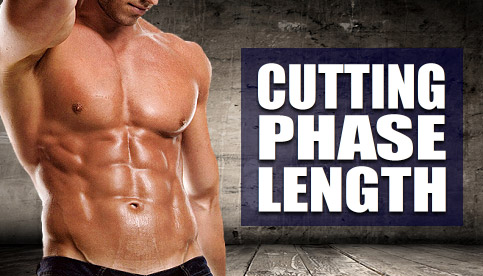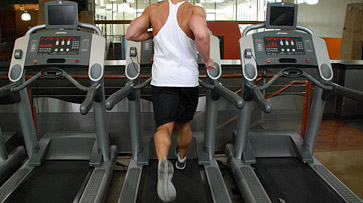HOW LONG TO CUT BEFORE BULKING? (IDEAL CUTTING PHASE LENGTH)

If your ultimate goal is to achieve an impressive, well-rounded and “aesthetic” looking physique, simply being “big” or “cut” isn’t enough.
You need a combination of both: a solid level of muscular development along with a relatively lean (but not too lean) body fat percentage to match.
In order to produce the proper balance between the two, achieving a sufficient level of overall leanness before committing to a focused bulking phase is a must.
Attempting to make significant muscle gains from too high a body fat percentage will usually set you up for failure in the long run, and this is a very common error that many beginning lifters make.
But exactly how long should you cut before bulking, and just how lean do you need to be before switching gears into “muscle building mode”?
The question of proper cutting phase length is actually pretty straightforward, and here’s the answer…
Proper Cutting Cycle Length: The Simple Answer

So, how long should your cutting phase last?
Simple…
Your cutting phase should last for whatever length of time is required in order to lean down to approximately 12% body fat.
If you prefer to get a bit leaner at around the 10-11% mark that would be fine. Bulking from a slightly higher percentage of about 13-14% will usually be okay as long as you structure things properly.
All in all though, somewhere around that 12% mark will be the right level for most trainees, which would be the point where your abs are pretty clearly visible under good lighting.
If you’re a female, then about 18-20% body fat will be the appropriate level.
The specific time frame required for this is highly individual, as it depends on several different factors. These include how high your starting body fat percentage is, how aggressively your cutting program is structured (whether it’s a larger calorie deficit over a shorter period of time or a smaller calorie deficit over a longer period of time), as well as how closely you adhere to your plan from week to week.
A standard rate of fat loss would land somewhere between 1-2 pounds per week, so if you factor this in with your current body weight/body fat percentage you can get a rough idea of how long this might take to achieve.
Why Bulking From A High Body Fat Percentage Is Usually A Bad Idea

Why is it so important to achieve a sufficient level of leanness first before adjusting your plan and putting the focus on muscle growth?
It’s because any time you eat in a calorie surplus in order to maximize hypertrophy, you’ll always gain a certain amount of body fat along the way.
You’re never going to lose fat in a calorie surplus; it’s a one-way street, and whatever fat you gain during that bulking phase is going to be stuck with you until you consciously decide to change up your plan and move into a calorie deficit.
What often happens is that a trainee will start bulking from, say, 17% body fat, and very quickly they’ll begin feeling bloated and unhappy with how they look as they see those additional fat gains accumulating.
This causes them to lose motivation and fall off track as a result, ultimately getting stuck in the all-too-common “yo’yo’ing” approach between back and forth bulking and cutting, never making any real progress in either direction.
You might think that putting on excess fat is no big deal to you, but I can almost guarantee that you’ll change your mind pretty fast once it actually becomes a reality (just ask me about my epic dirty bulking fail where I gained 30 pounds of fat).
By sticking to your cutting phase all the way through and only committing to your bulk once you’ve leaned down first, you’ll be setting yourself up for a much healthier and more sustainable muscle building phase that will maximize your chances of long term success.
As long as you structure your bulk properly by sticking to a controlled, moderate calorie surplus without trying to rush things, you’ll be able to gain muscle while staying lean for a much longer period of time without the risk of becoming de-motivated or falling off course.
“But I Don’t Want To Look Too Skinny!”

A lot of guys will shy away from that initial cutting phase out of fear that they’ll end up looking “too skinny” if they follow it all the way through.
However, the simple reality is that if you’re starting out with low levels of muscular development along with a high body fat percentage, your initial phase of training (whether it’s a bulk or a cut) is likely going to result in a physique that you’re temporarily dissatisfied with regardless.
If you truly want to build a great body and are in this for the long run, then you have to accept that the process requires time, patience, and hard work. There’s no “magic bullet” that is going to take you straight from where you are now straight to your ultimate physique.
It’s important that you shift into a longer term mindset and recognize that even if cutting down to 12% body fat did temporarily give you a thinner appearance, it’s ultimately just a stepping stone on the path to your final goal.
Besides, it’s going to be an improvement from where you currently are anyway, since being “skinny lean” will still look better than being skinny fat.
Also keep in mind that if you’re still in the beginning stages of training and you structure your cutting plan properly, there’s a good chance that you’ll be able to gain some muscle at the same time that you’re leaning down.
It won’t be to the same degree that you’d get by eating in a straight surplus, but the body can actually use the calories from stored fat in order to fuel muscle growth, and this is why some lifters (particularly beginners or those returning from a training layoff) can put on muscle and “recomposition” while in a calorie deficit.
How Long Should You Cut Before Bulking? The Bottom Line

Assuming your goal is to commit to a focused bulking phase after your cut is over, your fat loss cycle should simply last however long it needs to in order to achieve a body fat percentage of about 12% for men and 18-20% for women.
Once you’ve successfully leaned down to this level, you can then transition from cutting to bulking in order to add more overall lean mass to your frame.
Maintaining a reasonable level of leanness is the key to an aesthetic physique, and by always striving to keep body fat levels under control, you’ll be able to gain muscle and lose fat all year round while still looking great.
If you found this article helpful, make sure to sign up for your FREE custom fitness plan below...




